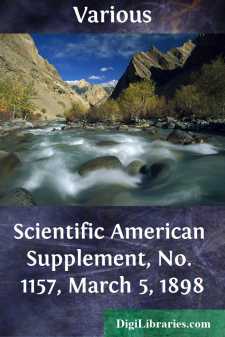Categories
- Antiques & Collectibles 13
- Architecture 36
- Art 48
- Bibles 22
- Biography & Autobiography 813
- Body, Mind & Spirit 142
- Business & Economics 28
- Children's Books 16
- Children's Fiction 13
- Computers 4
- Cooking 94
- Crafts & Hobbies 4
- Drama 346
- Education 46
- Family & Relationships 57
- Fiction 11829
- Games 19
- Gardening 17
- Health & Fitness 34
- History 1377
- House & Home 1
- Humor 147
- Juvenile Fiction 1873
- Juvenile Nonfiction 202
- Language Arts & Disciplines 88
- Law 16
- Literary Collections 686
- Literary Criticism 179
- Mathematics 13
- Medical 41
- Music 40
- Nature 179
- Non-Classifiable 1768
- Performing Arts 7
- Periodicals 1453
- Philosophy 64
- Photography 2
- Poetry 896
- Political Science 203
- Psychology 42
- Reference 154
- Religion 513
- Science 126
- Self-Help 84
- Social Science 81
- Sports & Recreation 34
- Study Aids 3
- Technology & Engineering 59
- Transportation 23
- Travel 463
- True Crime 29
The Mirror of Literature, Amusement, and Instruction Volume 13, No. 365, April 11, 1829
by: Various
Categories:
Description:
Excerpt
The Engraving on the annexed page is, perhaps, one of the greatest antiquarian treasures it has for some time been our good fortune to introduce to the readers of the MIRROR. It represents the original SOMERSET HOUSE, which derived its name from Edward Seymour, Duke of Somerset, maternal uncle to Edward VI., and Protector of the realm during most of the reign of that youthful sovereign. The time at which this nobleman commenced his magnificent palace (called Somerset House) has been generally faxed at the year 1549; but that he had a residence on this spot still earlier, is evident from two of his own letters, as well as from his "cofferer's" account, which states that from April 1, 1548, to October 7, 1551, "the entire cost of Somerset House, up to that period, amounted to 10,091l. 9s. 2d." By comparing this sum with the value of money in the present day, we may form some idea of the splendour of the Protector's palace, as well as from Stow, who, in his "Survaie," second edition, published in 1603, styles it "a large and beautiful house, but yet unfinished." The architect is supposed to have been John of Padua, who came to England in the reign of Henry VIII.—this being one of the first buildings designed from the Italian orders that was ever erected in this kingdom. Stow tells us there were several buildings pulled down to make room for this splendid structure, among which he enumerates the original parish church of St. Mary-le-Strand; Chester's or Strand Inne; a house belonging to the Bishop of Llandaff; "in the high street a fayre bridge, called Strand Bridge, and under it a lane or waye, down to the landing-place on the banke of Thames;" and the Inne or London lodging of the Bishop of Chester and the Bishop of Worcester. Seymour states, that the site of St. Mary's church became a part of the garden of Somerset House; and that when the Protector pulled down the old church, he promised to build a new one for the parishioners, but his death prevented his fulfilling that engagement. The Strand Bridge formed part of the public highway; and through it, according to Maitland, "ran a small watercourse from the fields, which, gliding along a lane below, had its influx to the Thames near Somerset Stairs."
Besides the places above mentioned, the palace-building Protector pulled down part of the Priory church of St. John, Clerkenwell, a chapel and cloisters near St. Paul's cathedral, for the sake of the materials. He was, however, soon overtaken by justice, for in the proclamation, October 8, 1549, against the Duke of Somerset, previously to his arrest, he is charged with "enriching himselfe," and building "sumptuous and faire houses," during "all times of the wars in France and Scotland, leaving the king's poore soldiers unpaid of their wages." After the attainder and execution of the Protector, on Tower Hill, January 22, 1552-3, Somerset Place devolved to the Crown, and was conferred by the king upon his sister, the Princess Elizabeth, who resided here during her short visit to the court in the reign of Queen Mary. Elizabeth, after her succession to the throne, lent Somerset Place to Lord Hunsdon, (her chamberlain,) whose guest she occasionally became. He died here in 1596. On the death of Elizabeth, it appears to have become a jointure-house, or dotarial palace, of the queens' consort; of whom Anne of Denmark, queen of James I. kept a splendid court here. Arthur Wilson, in his "History of King James," generally calls this mansion "the queen's palace in the Strand;" but it was more commonly called Denmark House; and Strype says that by the queen "this house was much repaired and beautified, and improved by new buildings and enlargements. She also brought hither water from Hyde Park in pipes." Dr. Fuller remarks that this edifice was so tenacious of the name of the Duke of Somerset, "though he was not full five years possessor of it, that he would not change a duchy for a kingdom, when solemnly proclaimed by King James, Denmark House, from the king of Denmark lodging therein, and his sister, Queen Anne, repairing thereof."
Pennant says, "Inigo Jones built the back-front and water-gate about the year 1623;" but it may be questioned whether these were not the new buildings spoken of as having been previously raised by Anne of Denmark. Pennant likewise speaks of the chapel which was begun by Jones in the same year.
Denmark House was next fitted up for Henrietta Maria, queen of Charles I., and settled on her for life. By her marriage articles, extraordinary concessions were made in favour of the Catholics. The queen was not only allowed to have, herself, the free exercise of the "Roman Catholic Apostolic religion," but all her children were to be brought up in the same faith; she was to have a chapel in all the royal palaces; a bishop of her own faith was to be her almoner; twenty-eight priests, or ecclesiastics, were to serve in her chapel; the domestics of her household were to be French Catholics, &c. Thus, this mansion became the very focus of Catholicism, and a convent of Capuchin friars was established here by the queen. At length, in 1642, it was ordered by the Parliament that "the altar and chapel in Somerset House be forthwith burnt," and that the Capuchins be "sent into France."
In 1659, the Commons resolved that Somerset House, with all its appurtenances, should be sold for the partial discharge of the great arrears due to the army; and Ludlow states, that it was sold for 10,000l....












